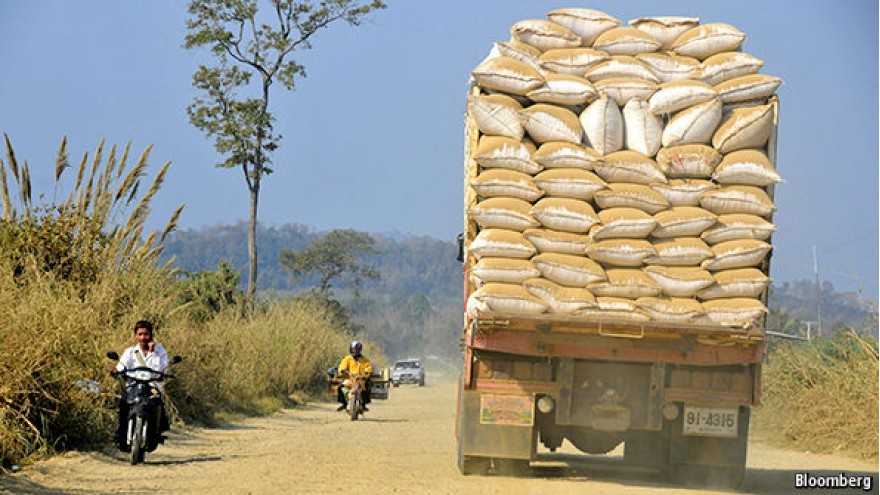Oily food
Oil first. Cheap fuel means cheaper food. Natural gas, whose price is tied to that of oil, is used for producing fertiliser; other hydrocarbons are used for machinery and transport. Roughly 20% of the cost of producing grain comes from oil, according to Kona Haque at ED&F Man, an agricultural-commodities merchant. Cheap oil also means less demand for biofuels, which in turn means cheaper food because of reduced appetite for grains used in biofuels, particularly maize (corn). Biofuel demand, once an insignificant feature of food markets, now has a sizeable impact: from 2000 to 2011, America went from using 6% of its corn crop (the world’s biggest) to make ethanol, to 40%.
THE prices of staple crops, like those of other commodities, are falling fast. In August they reached their lowest level for eight years, down by over 41% from their peak in 2011. That is not because people are eating less, or because farmers have become much more productive. Nor is it because of a slowdown in Chinese growth, in contrast to many other commodities. Whether going down or up, food prices are largely driven by other factors, among them oil prices and government policy.
Derek Headey and Shenggen Fan of the International Food Policy Research Institute, based in Washington, DC, estimate that the rising cost of oil increased the price of American corn, wheat and soybeans by 30-40% between 2001 and 2007 simply by raising input costs. Adding in the impact of higher oil prices on the demand for biofuels, the effect on food prices was even greater, according to a paper by Sheng-Tung Chen, Hsiao-I Kuo and Chi-Chung Chen, three economists in Taiwan.
Just as the price of food went up with that of oil, its current fall owes more to low oil prices than a self-correcting food market, says Josef Schmidhuber of the UN’s Food and Agriculture Organisation. In theory, when prices rise, producers should respond by expanding supply. But investment in agriculture did not increase in response to price increases. It dropped by 4.5% in real terms during a run-up in prices in 2008, and remained flat despite the price spike of 2011-12.
In part, this is simply a matter of timing. Agricultural investment naturally lags price movements, since it takes time to bring more land under cultivation and grow a new crop. But even allowing for that, the rich world seemed blind to the price signals of 2008 and 2011, presumably because of the credit crunch and a lack of unused arable land. Britain’s Overseas Development Institute found that only 23% of the post-2008 expansion in cereal supply came from rich-world commercial farms.
Instead, production was ramped up in developing countries, particularly in Asia and Africa. India accounted for 29% of the global increase in wheat production between 2005 and 2013. Taken together, China, India and Vietnam accounted for 61% of the global rise in rice production. However, it was not the market that induced this rise, but governments. Policymakers wanted to support domestic agriculture after seeing how the price spike could threaten their food security.
India added to subsidies on fertilisers and power for farmers, as well as cancelling the debts of small farmers and offering them fresh credit. At the same time as dampening prices for consumers by releasing grain stocks, the government raised the “support” prices at which it buys up excess grain. All told, both China and India increased annual government spending on agriculture by 20-30% in 2008.
For all the extra grain produced, government interference made the price increases worse in many respects. As the price of rice started to creep up in late 2007, China, India, Vietnam and many other producers began restricting rice exports. Such policies can help keep domestic prices down, but they worsen food shortages for everyone else. India’s ban led to great hardship in neighbouring Bangladesh: as the share of Bangladesh’s rice imports coming from India fell from 95% in 2007 to 3% in 2009, local rice prices almost doubled. Will Martin and Kym Anderson of the World Bank found that export bans explained 45% of the increase in international rice prices. Fear of shortages also led to stockpiling: the Philippines imported more rice in the first quarter of 2008 than it had for the whole of the previous year.
Grain stocks were low in 2008, which left little cushion when prices began to surge. But even though stocks have since been rebuilt, they may not be of much use during the next price spike. Robert Subbaraman of Nomura, an investment bank, argues that stocks are concentrated in developing countries such as China and Thailand that could resort to export bans in times of high prices. Such a moment may not be far off: the incipient El Niño weather pattern normally provokes chaos in agricultural markets.





Comments